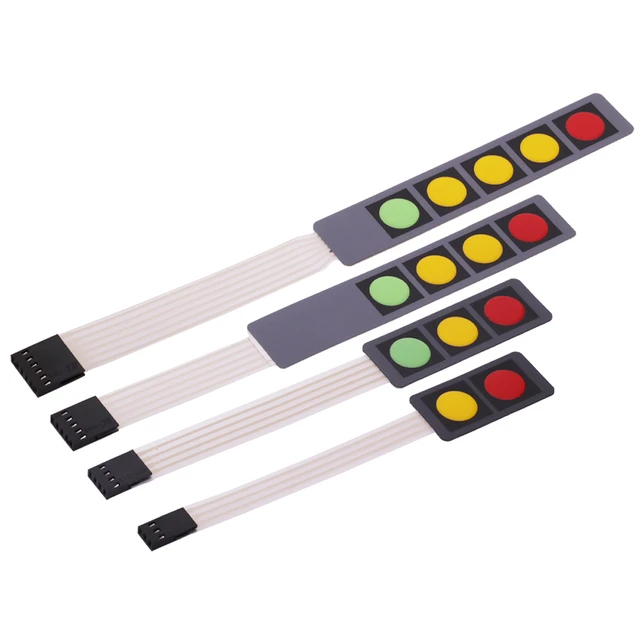How Membrane Switches Are Shaping the Future of Electronic Interfaces
How Membrane Switches Are Shaping the Future of Electronic Interfaces
Blog Article
Comprehending Membrane Changes: The Trick to Sturdy and Reliable Controls

What Are Membrane Layer Buttons?
Membrane buttons are an innovative option in the world of interface technology, incorporating performance and layout seamlessly. These devices act as an interface in between users and electronic systems, incorporating numerous elements into a small format. Usually built from adaptable, slim layers of materials, membrane layer switches are designed to reply to touch, enabling customers to engage with machinery and digital devices properly.
The main elements of a membrane layer switch include a published circuit layer, graphic overlay, and a spacer layer that protects against unintended activation. The visuals overlay can be tailored to mirror brand name identity or customer preferences, boosting visual appeals while guaranteeing usability. Membrane layer switches are typically used in different applications, including medical gadgets, consumer electronics, and commercial equipment, owing to their durability and resistance to ecological variables such as dampness and dirt.
One of the essential benefits of membrane buttons is their capacity to endure wear and tear, making them optimal for high-traffic environments. Additionally, they are lightweight and need marginal area, enabling ingenious styles in product development. Overall, membrane layer changes represent a practical and reliable option for modern-day electronic user interfaces, weding innovation with user-centric layout principles.
Exactly How Membrane Layer Switches Work
The operation of membrane switches joints on a basic yet efficient system that converts customer input into digital signals. When a customer presses the switch, the leading layer deforms, enabling a conductive aspect in the circuit layer to make call with an equivalent conductive pad on the underside of the visuals overlay.
The layout of membrane switches can differ, however they often integrate domes or tactile aspects to provide responses to the individual, enhancing the general experience - membrane switch. The materials used in membrane layer buttons, such as polyester or polycarbonate, add to their resilience and resistance to environmental aspects, including moisture and dust. The published circuits are generally encapsulated, which shields them from wear and tear over time.
Advantages of Membrane Layer Switches

Additionally, membrane layer switches are recognized for their toughness. Created from durable products, they are resistant to dust, dampness, and physical wear, which dramatically extends their life expectancy compared to typical mechanical switches. This sturdiness makes them specifically appropriate for high-traffic atmospheres and applications needing long life.
One more substantial advantage is the simplicity of cleaning and upkeep. The smooth surface area of membrane switches lessens dirt build-up and is often invulnerable look here to spills, making them perfect for setups that call for constant sanitization.
Furthermore, membrane layer buttons supply a structured account, bring about a thinner style that can be integrated right into various gadgets without including mass. This feature not only improves the aesthetic appeal but also adds to a more ergonomic item layout.
Applications of Membrane Switches
Easy to use and functional, membrane buttons locate applications across a wide variety of sectors, including clinical tools, consumer electronics, and commercial tools. In the medical field, these switches are integral to tools such as diagnostic equipment, individual tracking systems, and mixture pumps, where dependability and ease of cleaning are crucial. Their capability to withstand harsh atmospheres and keep capability makes them optimal for such applications.

In customer electronic devices, membrane layer switches are utilized in products like microwaves, cleaning devices, and push-button click reference controls - membrane switch. Their smooth design permits user-friendly interface, enhancing the total user experience while offering longevity and resistance to tear and wear
Commercial devices additionally gains from membrane buttons, especially in control panels for equipment and automation systems. These switches provide security against dirt and wetness, making certain consistent efficiency in tough environments. Additionally, their personalized functions allow suppliers to customize them to certain operational demands, boosting effectiveness and performance.
Selecting the Right Membrane Change
When selecting a membrane button, it is vital to think about various variables that affect efficiency and suitability for particular applications. The key factors to consider include ecological problems, responsive feedback, resilience, and design requirements.
First, examine the operating atmosphere; buttons subjected to dampness, chemicals, or extreme temperatures call for specific products to guarantee durability and capability. Next off, examine the demand for tactile feedback. Depending on customer interaction, some applications might take advantage of a tactile feedback to confirm activation, while others may like a non-tactile style for visual factors.
Resilience is an additional important variable; membrane switches need to be made to hold up against regular usage, effects, and abrasion. Make sure the picked button can endure the anticipated lifecycle, specifically in high-usage scenarios.

Conclusion
To conclude, membrane layer switches over work as vital components in the style of reliable and durable control systems throughout different markets. Their portable layout, integrated with durable building and customizable functions, improves customer interaction while guaranteeing longevity sought after environments. The versatility of membrane layer switches over permits tailored solutions that meet particular operational demands, strengthening their relevance in contemporary technology. As markets proceed to progress, the significance of integrating effective membrane layer button options can not be overstated.
Membrane switches over represent a critical aspect of modern interface style, mixing performance with strength in numerous applications.Membrane layer buttons are an advanced remedy in the world of individual interface technology, incorporating functionality and design seamlessly. Generally created from adaptable, slim layers of products, membrane buttons are created to react to touch, enabling individuals to communicate with machinery and digital tools properly.
The layout of membrane try here switches can differ, but they typically include domes or responsive aspects to offer comments to the individual, enhancing the general experience.In final thought, membrane layer changes offer as essential components in the design of trustworthy and sturdy control systems throughout numerous sectors.
Report this page